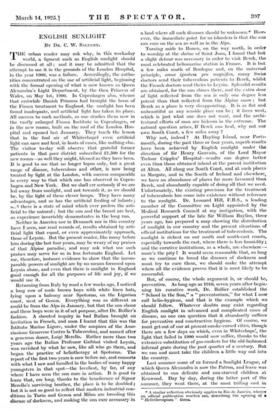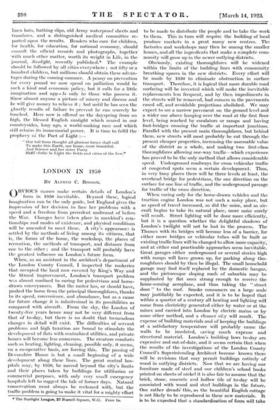ENGLISH SUNLIGHT
BY DR. C. W. SALEEBY.
THE urban reader may ask why, in this workaday world, a figment such as English sunlight should be discussed at all ; and it may be admitted that the attempt to use it in the grounds of the London Hospital, in the year 1900, was a failure. Accordingly, the autho- rities concentrated on the use of artificial fight, beginning with the formal opening of what is now known as Queen Alexandra's Light Department, by the then Princess of Wales, on May 1st, 1900. In Copenhagen also, whence that erstwhile Danish Princess had brought the boon of the Finsen treatment to England, the sunlight has been found inadequate, and artificial light has taken its place. All success to such methods, as one studies them now in the vastly enlarged Finsen Institute in Copenhagen, or in the new rooms, built on the roof of the London Hos- pital and opened last January. They teach the lesson that in the foul air of Whitechapel even artificial light can save and heal, in hosts of cases, like nothing else. The visitor to-day will observe that grateful former patients in' that poor district subscribed £1,500 for the new rooms—as well they might, blessed as they have been. It is good to see that no longer lupus only, but a great range of disease, tuberculous and other, is now being treated by light at the London, with success comparable in every way to that which one has observed in Copen- hagen and New York. But we shall err seriously if we arc led away from sunlight, and not towards it, as we should be, by the light of these clever lamps. They have many advantages, and so has the artificial feeding of infants ; a.3 there is a state of mind which ever prefers the arti- ficial to the natural ; but the sun and the breast are best, as experience invariably demonstrates in the long run.
Neither in Ainerica nor in Denmark nor in this country have I seen, nor read records of, results obtained by arti- ficial light that equal, or even approximately approach, those of Leysin. But the present reader, like many before him during the last four years, may be weary of my praises of that Alpine paradise, and may ask what use such praises may serve for us in less fortunate England. Let me, therefore, instance evidence to show that the incom- parable powers of sunlight are by no means focussed upon Leysin alone, and even that there is sunlight in England good enough for all the purposes of life and joy, if we would use it.
Returning from Italy by road a few weeks ago, I noticed a long row of nude brown boys with white linen hats, lying upon a balcony near Spotomo, on the Ligurian coast, west of Genoa. Everything was as different as could be from the Alps in January, but that the sun shone and these boys were in it of set purpose, after Dr. Roller's fashion. A shouted inquiry in bad Italian brought an invitation in French, and soon I learnt that this was the Istituto Marino Ligurc, under the auspices of the Asso- ciazione Genovese Contro In Tuberculosi, and named after a generous donor, Luigi Merello. Rather more than two years ago the Italian Professor Gaibissi visited Leysin, was ravished by what he saw, like all who go there, and began the practice of heliotherapy at Spotorno. The report of the first two years is now before me, and consorts with what I saw and handled in the bodies of many happy youngsters in that spot—the loveliest, by far, of any where I have seen the sun cure in action. It is good to learn that, ere long, thanks to the beneficence of Signor Merello's surviving brother, the place is to be doubled ; but it is not so good to reflect that modern industrial con- - ditions in Turin and Genoa and Milan are breeding this disease of darkness, and making the sun cure necessary in a land where all such diseases should be unknown.* How. ever, the immediate point for us islanders is that the sun can cure on the sea as well as in the Alps.
Turning aside to Rouen, on the way north, in order to worship at the shrine of Saint Joan, I found that but a slight detour was necessary in order to visit Bcrck, the most celebrated heliomarine station in France. It is but a few miles south of Boulogne and, on the universal principle, omne ignotum pro magnifico, many Swiss doctors send their tuberculous patients to Derek, whilst the French doctors send theirs to Leysin. Splendid results are obtained, for the sun shines there, and the extra dose of light reflected from the sea is only one degree less potent than that reflected from the Alpine snow ; but Berck as a place is very disappointing. It is as flat and unbeautiful as any seaside place can be ; it faces west, which is just what one does not want, and the archi- tectural efforts of man are hideous in the extreme. The natural question arises, If Buck can heal, why not our own South Coast, a few miles away ?
Why not, indeed ? At Hayling Island, near Ports- mouth, during the past three or four years, superb results have been achieved by English sunlight under the direction of Sir Henry Gauvain, of the Lord Mayor Treloar Cripples' Hospital—results one degree better even than those obtained inland at the parent institution at Alton. All along our South Coast, and at such places as Margate, and in the South of Ireland and elsewhere, we have an abundance of places far more favoured than Derek, and abundantly capable of doing all that we need. Unfortunately, the existing provision for the treatment of tuberculosis has come into existence without reference to the sunlight. Dr. Leonard Hill, F.R.S., a leading member of the Committee on Light appointed by the Medical Research Council at my instigation, with the powerful support of the late Sir William Bayliss, three years ago, has prepared a. map showing the distributioe, of sunlight in our country and the present situations of official institutions for the treatment of tuberculosis. The sunlight is richest on our south and south-east coasts, especially towards the east, where there is less humidity; and the curative institutions, as a whole, arc elsewhere- more's the pity I It would seem. reasonable that, so long as we continue to breed the diseases of darkness and must try to cure them, we should make the attempt where all the evidence proves that it is most likely to be successful.
But, of course, the whole argument is, or should be, preventive. As long ago as 1910, seven years after begin- ning his curative work, Dr. Rollier established the " School in the Sun," a " preventorium," for what I now call hello-hygiene, and that is the example which we should follow. Whatever doubts may exist regarding English sunlight in advanced and complicated cases of disease, no one can question that it abundantly suffices for preventive and constructive hygiene. Of course, wo must get out of our at present smoke-cursed cities, though there are a few days on which, even in Whitcchape', tho light that failed in 1900 would now suffice, thanks to the extensive substitution of gas-cookers for the old-fashioned infernal grate during the past quarter of a century. But we can and must take the children a little way out into the country.
Last summer some of us formed a Sunlight League, of which Queen Alexandra is now the Patron, and leave was obtained to sun delicate and sun-starved children at Kenwood. Day by day, during the latter part of the summer, they went there, at the most trifling cost in • A similar reflection obviously applies to Rio de Janeiro, whence an official publication reaches me, describing the opening of a " Heliotherafaum " there. linen hats, bathing slips, old Army waterproof sheets and tramfares, and a distinguished medical committee re- ported upon the results. Readers who care for children, for health, for education, for national economy, should consult the official records and photographs, together with much other matter, worth its weight in Life, in the journal, Sunlight, - recently published.* The example should be followed by all cities everywhere ; • not fifty or a hundred children, but millions' should obtain these adVan- tages during the coming summer. A penny on prevention for every pound we now spend on palliation would be such a kind and economic policy, but it calls for a little imagination and app:411s only to those who possess it. Show almost anyone a picture of misery and disease and he will give money to relieve it ; but until'he has seen the ghastly- results Of failure to prevent he can scarcely be touched. Here -now is offered us the dayspring froni on high, the blessed English sunlight which reared in our countrysides, long ago, a world-making race and which still retains its immemorial -power. It is time to fulfil the prophecy of the Poet of Light :-- " Our toil from thought all glorious forms shall cull To make this Earth, our home, more beautiful, And Science and her sister Poesy
Shall clothe in Light the fields and cities of the free."















































 Previous page
Previous page